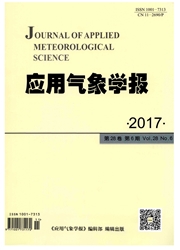

 中文摘要:
中文摘要:
利用影响南海夏季风年际变化的主要气候现象厄尔尼诺-南方涛动(El Nino-Southern Oscillation,ENSO)和对流层准两年振荡(Tropospheric Biennial Oscillation,TBO)相关的气候因子,提出了以过程判别函数确定物理过程的持续性,建立年际尺度的集成物理统计预测模型,而非年际尺度变率由经验统计模型预测,二者相结合,发展了集成物理-经验统计预测模型。经验模型在拟合时段的回报结果很好,但在独立样本预测时效果明显降低,其中预测评分(PS)降低了23%,距平相关系数(ACC)降低了63%;相比之下,集成物理-经验统计预测模型在独立样本预测时比经验模型有更好的预测结果(PS评分提高了9.5%,ACC提高了75%),且预测结果相对稳定。此外,集成物理-经验统计预测模型对南海夏季风降水的空间分布也有一定预测能力。
 英文摘要:
英文摘要:
The South China Sea summer monsoon (SCSSM) is flood season of South China. However, the prediction of namic or statistic methods, Statistic methods are used in a tropical system that plays a key role during the the SCSSM strength is difficult by no matter dypractice rather than dynamic model, but empirical-statistic models always have good hindcasting results during the period of building model, while the forecasting skills decrease evidently in practice. Physical-statistic methods have relatively stable predictive skill when the persistence of physical processes is taken into account. Therefore, an integrated technique is introduced based on associated physical processes to establish a predictive model for SCSSM. It is well known that the rainfall of SCSSM has multi-scale climate variability, for example, quasi-biennial and qua- si-quadrennial time scale, which are mainly related to TBO (Tropospheric Biennial Oscillation) and ENSO (El Nino-Southern Oscillation), respectively. Based on the corresponding climatic factors, a physical-statistic integrated model is built. Combined with the traditional empirical-statistic method, a new prediction model (namely physical and empirical-statistic integrated model) for SCSSM is developed. First, original data are processed by removing the climatic state (1981--2010) and linear trend, and then anomalous data are filtered on the TBO (12--36 months) and ENSO (36--96 months) time scales since the biennial mode of SCSSM has little connection with the ENSO. Second, regressed results based on climatic factors (e. g. , sea surface temperature anomalies in Nino3.4 and the tropical western Pacific, precipitation anomalies over the maritime continent and Australian monsoon region) are assembled according to a discrimination function that is correlation coefficient larger than 0. 05 significant level between regressed results and the filtered SCSSM precipitation. Moreover, the rest precipitation with SCSSM interannual variations removed is predicted by
 同期刊论文项目
同期刊论文项目
 同项目期刊论文
同项目期刊论文
 期刊信息
期刊信息
